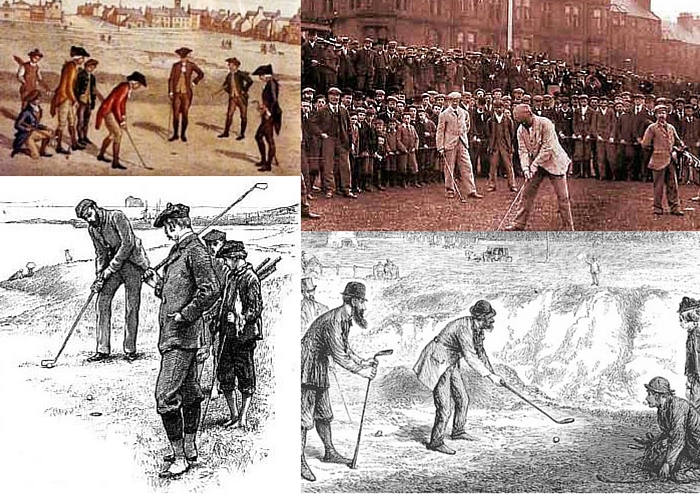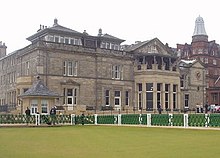The origins of golf are unclear and much debated. However, it is generally accepted that modern golf developed in Scotland during the Middle Ages. The game did not find international popularity until the late 19th century, when it spread into the rest of the United Kingdom and then to the British Empire and the United States.
A golf-like game is, apocryphally,[1][2] recorded as taking place on 26 February 1297, in Loenen aan de Vecht, where the Dutch played a game with a stick and leather ball. The winner was whoever hit the ball with the least number of strokes into a target several hundred yards away. Some scholars argue that this game of putting a small ball in a hole in the ground using golf clubs was also played in 17th-century Netherlands and that this predates the game in Scotland. There are also other reports of earlier accounts of a golf-like game from continental Europe.[3]
In the 1261 Middle-Dutch manuscript of the Flemish poet Jacob van Maerlant‘s Boeck Merlijn mention is made of a ball game “mit ener coluen” (with a colf/kolf [club]). This is the earliest known mention in the Dutch language of the game of colf/kolf as played in the Low Countries.[4][5]
In 1360, the council of Brussels banned the game of colf: “… wie met colven tsolt es om twintich scell’ oft op hare overste cleet …” (he who plays at colf pays a fine of 20 shillings or his overcoat will be confiscated).[6]
In 1387, the regent of the county of Holland, Zeeland and Hainaut, Albrecht of Bavaria, sealed a charter for the city of Brielle, in which it was forbidden to play any game for money. One of the exceptions to this ordinance was “den bal mitter colven te slaen buten der veste” (to play the ball with a club outside the town walls).[7] Two years later, in 1389, the regent Albrecht offered the citizens of Haarlem a field called ‘De Baen’ (the course) to be used exclusively for playing games – especially colf – because these were too dangerous within the city walls.[8]
In 1597 the crew of Willem Barentsz played “colf” during their stay at Nova Zembla, as recorded by Gerrit de Veer in his diary:
- Den 3. April wast moy claer weder met een n.o. wint ende stil, doen maeckten wy een colf toe om daer mede te colven, om also onse leden wat radder te maeckten, daer wy allerley middelen toe zochten.[9]
- (The 3rd of April the weather was nice and clear with a north-easterly wind and quiet, then we made a colf [club] to play colf with, and thus make our limbs more loose, for which we sought every means)
Early golf in Scotland
The modern game of golf is generally considered to be a Scottish invention. A spokesman for the Royal and Ancient Golf Club of St. Andrews, one of the oldest Scottish golf organisations, said “Stick and ball games have been around for many centuries, but golf as we know it today, played over 18 holes, clearly originated in Scotland.”[10][11] The word golf, or in Scots gowf [gʌuf], is usually thought to be a Scots alteration of Dutch “colf” or “colve” meaning “stick, “club“, “bat“, itself related to the Proto-Germanic language *kulth- as found in Old Norse kolfr meaning “bell clapper”, and the German Kolben meaning “mace or club”.[12] The Dutch term Kolven refers to a related sport.
The first documented mention of golf in Scotland appears in a 1457 Act of the Scottish Parliament, an edict issued by King James II of Scotland prohibiting the playing of the games of gowf and football as these were a distraction from archery practice for military purposes.[13] Bans were again imposed in Acts of 1471 and 1491, with golf being described as “an unprofitable sport”. Mary, Queen of Scots was accused by her political enemies of playing golf after her second husband, Henry Stuart, Lord Darnley, was murdered in 1567.[vague] George Buchanan subsequently wrote that she had been playing “sports that were clearly unsuitable to women”. Golf was banned again by parliament under King James IV of Scotland, but golf clubs and balls were bought for him in 1502 when he was visiting Perth, and on subsequent occasions when he was in St Andrews and Edinburgh.[14]
An entry in the Town Council Minutes of Edinburgh for 19 April 1592 includes golf in a list of pursuits to be avoided on the Sabbath.[15]
The account book of lawyer Sir John Foulis of Ravelston records that he played golf at Musselburgh Links on 2 March 1672, and this has been accepted as proving that The Old Links, Musselburgh, is the oldest playing golf course in the world. There is also a story that Mary, Queen of Scots, played there in 1567.[16][17]


